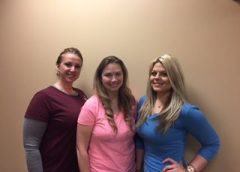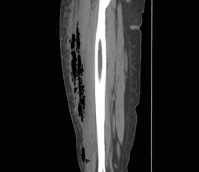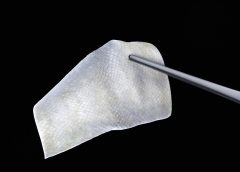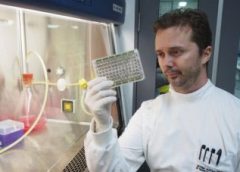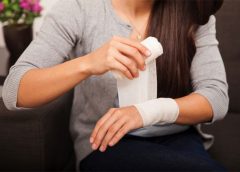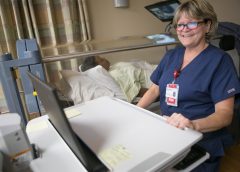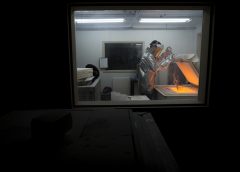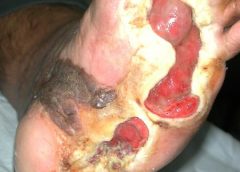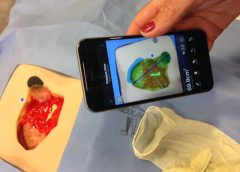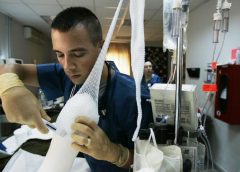Three registered nurses (RN) at Panhandle Home Health have passed the National Wound Care & Ostomy Certification Course & Exam (WCC) as part of Panhandle Home Health’s Wound Care Initiative, started in 2013 with a single WCC-certified RN, Cathy Reifer. In 2015, WISH (Women Investing in Shepherd) awarded their inaugural grant to a regional nonprofit, Panhandle Home Health. This grant of $26,250, along with additional private donations and grants, has allowed thirteen nurses to participate in the intensive, week-long training course. These RNs are prepared to provide specialized consultation and a unique supervisory level of clinical expertise in wound assessment and the specialized care involved for patients. Their training involves differentiation of wound types and the appropriate care; recognizing the effects of cancer, heart disease, diabetes, or COPD on wound healing; understanding care products and their implementation; wound-healing techniques; and patient education. (more…)
Read MoreSearch Results for: Spi
Necrotizing Fasciitis: Pearls & Pitfalls
A 39-year-old woman presents to the ED with leg pain and fever. She initially noted redness and pain above her knee 2 weeks ago and was evaluated at an outside hospital. She completed a 10-day course of oral antibiotics for cellulitis. Over the last two days, she has had progressive leg swelling of her entire right thigh. The pain is now so severe that she is having difficulty walking. Her past medical history is negative for diabetes mellitus, chronic liver disease, or alcohol and IV drug use.
On exam, she is febrile to 102.7 F, heart rate is 96 bpm, and blood pressure is 112/65. She has a 12 cm area of faint erythema on her right thigh and tenderness to palpation of her entire right leg with diffuse edema. There is no ecchymosis or bullae formation. (more…)
Read MoreFish Skin for Human Wounds: Iceland’s Pioneering Treatment
The FDA-approved skin substitute reduces inflammation and transforms chronic wounds into acute injuries.
Six hours north of Reykjavik, along a narrow road tracing windswept fjords, is the Icelandic town of Isafjordur, home of 3,000 people and the midnight sun. On a blustery May afternoon, snow still fills the couloirs that loom over the docks, where the Pall Palsson, a 583-ton trawler, has just returned from a three-day trip. Below the rust-spotted deck, neat boxes are packed with freshly caught fish and ice. “If you take all the skins from that trawler,” says Fertram Sigurjonsson, the chairman and chief executive officer of Kerecis Ltd., gesturing over the catch, “we would be able to treat one in five wounds in the world.” (more…)
Read MoreWound-healing molecule found in parasitic worm could help prevent amputations
A substance found in parasitic worms’ spit might help prevent thousands of amputations a year, scientists in north Queensland have said. James Cook University researchers in Cairns are harnessing the molecule produced by a Thai liver parasite that can “supercharge” the healing of wounds.
Australian Institute of Tropical Health and Medicine parasitologist Michael Smout said non-healing wounds were of particular concern for diabetics and smokers. Dr Smout said the parasite used the molecule to keep its host healthy and prolong its own life. “It’ll live for a decade or two, and it’s munching around your liver, and zipping up the wounds as it goes,” he said. (more…)
Read MoreSmart bandage uses nanosensors to track how a wound is healing
Bandages are intended to keep a dressing secure and clean in order to reduce healing time and infection rate. However, they may be about to get a new use-case, courtesy of a project from the United Kingdom’s Swansea University Institute of Life Science.
What researchers there have been working on is a new smart bandage capable of tracking how a wound is healing and sending that data back to doctors, via 5G technology. To do this it would employ tiny “nanosensors” able to fit comfortably within the fabric of regular bandages. (more…)
Read MoreAtrium Medical Center division earns award for clinical excellence
MIDDLETOWNThe Wound Care Center and Hyperbaric Services at Atrium Medical Center recently was recognized with a national award for clinical excellence.
The Center of Distinction Award was presented by Healogics, the nation’s leading and largest wound care management company. The center was also honored with the Healogics President’s Circle Award.
The awards recognize outstanding clinical outcomes for 12 consecutive months, including patient satisfaction higher than 92 percent, and a wound healing rate of at least 91 percent in less than 31 median days. (more…)
Read MoreWound care technology invented at S&T hits marketplace
A glass-based wound care product that emerged from research by a doctoral student at Missouri University of Science and Technology has been approved by the U.S. Food and Drug Administration for human use and is now available on the commercial market.
Steve Jung laid the groundwork for the Mirragen Advanced Wound Matrix while earning a master’s degree in ceramic engineering and a Ph.D. in materials science and engineering at Missouri S&T. Jung is now chief technology officer at Mo-Sci Corp., a Rolla specialty glass manufacturer that continued the product’s development in collaboration with ETS Wound Care, also of Rolla. (more…)
Read MoreControl your claims: Pressure ulcer/wound care management
One of many dreaded tags from a Centers for Medicare & Medicaid Survey is F-Tag 314 — Pressure ulcers.
CMS writes, “Each resident must receive and the facility must provide the necessary care and services to attain or maintain the highest practicable physical, mental, and psychosocial well-being, in accordance with the comprehensive assessment and plan of care.” (more…)
Read MoreCovenant Health Wound Care Experts Earn National, Regional Recognition
LUBBOCK, TX (NEWS RELEASE) – The Covenant Center for Wound Care & Hyperbaric Medicine has been honored as a Wound Care Center® of the Year by Healogics, Inc., the nation’s leading and largest wound care management company. The center also was awarded Center of Distinction and the President’s Circle Award.
The center has achieved patient satisfaction rates higher than 92 percent, a healing rate of at least 91 percent in less than 31 median days and healed almost 90 percent of its patients in less than 14 weeks. Out of the 630 Centers eligible in 2016, only seven centers across the country received this prestigious award. Covenant’s center was awarded as Center of the Year for the southwest region, which includes Texas, Oklahoma, Louisiana and New Mexico. (more…)
Read MoreImaging technology to aid wound care
Nash UNC Health Care is continuing its effort to bring cutting-edge technology to the hospital.
Through a recent partnership with a Maryland-based medical imaging and data analytics company called Tissue Analytics, which is dedicated to revolutionizing wound care, Nash UNC Health Care has adopted new state-of-the-art wound imaging technology to its outpatient Wound Care Center. (more…)
Read MoreRevealing Advanced Wound Care Market Growth Factors
At a time when governments are under pressure to reduce healthcare costs, the global advanced wound care market is growing, driven by an aging population and rising incidences of chronic wounds.
Advanced wound care products are typically used to manage complex wounds, including burns, chronic wounds and complex trauma and surgical wounds. Chronic and complex wounds represent one of the predominant challenges to global healthcare systems because they are hard to heal and expensive to treat. (more…)
Read MoreSupport surfaces
BY: NANCY MORGAN, RN, BSN, MBA, WOCN, WCC, CWCMS, DWC
Support surfaces are geared for managing our patients’ tissue load and redistributing it to prevent skin breakdown. There are three types of pressure redistribution mattresses available, classified as group 1, group 2, and group 3. Group 1 mattresses lack a power source and maintain a constant state of inflation. They include foam mattresses, gel mattresses, and air mattresses. Group 2 support surfaces, such as powered, low-air-loss, and alternating pressure mattresses use inflation and deflation to spread the tissue load over a large surface area. Group 3 mattresses include the air-fluidized mattress, a special type of powered mattress that provides the highest-pressure redistribution via a fluid-like medium created by forcing air through beads, as characterized by immersion and envelopment. (more…)

